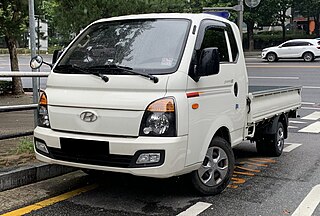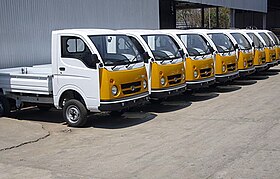
Tata Motors Limited is an Indian multinational automotive company, headquartered in Mumbai and part of the Tata Group. The company produces cars, trucks, vans, and buses.

The Tata Safari is a mid-size SUV produced by the Indian automobile manufacturer Tata Motors since 1998. The first-generation Safari has been designed as a seven-seater SUV with a foldable third row, roomy interior; on the market it has positioned itself as an alternative from the competitive price to other brands off-road vehicles.

The Tata Sumo is an SUV produced by the Indian automobile manufacturer Tata Motors from 1994 to 2019. During production its name was changed to Sumo Victa and later to Sumo Gold.

The Hyundai Porter, also known as the Hyundai H-100, is a cabover Pickup truck produced by the South Korean manufacturer Hyundai since 1977.

The Toyota HiAce is a light commercial vehicle produced by the Japanese automobile manufacturer Toyota. First launched in October 1967, the HiAce has since been available in a wide range of body configurations, including a minivan/MPV, minibus, panel van, crew van, pickup truck, taxi and an ambulance.

The Daihatsu Hijet is a cab over microvan and kei truck produced and sold by the Japanese automaker Daihatsu since 1960. Despite the similarities between the Hijet name and Toyota's naming scheme for its trucks and vans, the name "Hijet" has been in use for Daihatsu's kei trucks and microvans since 1960, over two decades before Toyota took control. "Hijet", when transliterated into Japanese, is very similar to "Midget", one of Daihatsu's other mini-trucks. According to Daihatsu, the name "Hijet" was created to imply that the vehicle offers higher performance than the Midget. The Hijet competes in Japan with the Honda Acty, Mitsubishi Minicab, Nissan Clipper, Subaru Sambar and Suzuki Carry.

The Tata Telcoline is a mid-size pickup truck made by the Indian automaker Tata Motors since 1988. In India, it was originally known as the Tatamobile 206, and since 2002, the name was changed to the Tata 207 DI. In export markets, it has been sold as the Tatamobile, Tata Loadbeta, or simply Tata Pick Up.

The Suzuki Carry is a kei truck produced by the Japanese automaker Suzuki. The microvan version was originally called the Carry van until 1982 when the passenger van versions were renamed as the Suzuki Every. In Japan, the Carry and Every are kei cars but the Suzuki Every Plus, the bigger version of Every, had a longer bonnet for safety purposes and a larger engine; export market versions and derivatives have been fitted with engines of up to 1.6 liters displacement. They have been sold under myriad different names in several countries, and is the only car to have been offered with Chevrolet as well as Ford badges.

The Tata Nano is a city car/microcar manufactured and marketed by Indian automaker Tata Motors over a single generation from 2008–2018, primarily in India, as an inexpensive rear-engine hatchback for motorcycle and scooter drivers — with a launch price of ₹100,000 on 10 January 2008.
Girish Wagh is currently the Executive Director of Tata Motors. He was previously leading the Commercial Vehicle Business Unit at Tata Motors. He earlier worked in the capacity of Sr. Vice President(Tata Small & Passenger Car Segment) & Head Project Planning and Program Management of Tata Motors. He is a key figure in the Tata Nano's project.

The Tata Aria is a full-size crossover SUV manufactured by Tata Motors of India. Tata Aria was launched on 5 January 2010 at Auto Expo, Delhi, and was launched to customers on 12 October 2010 and prices started at 10.4 lakhs INR Ex showroom or. It is based upon the Tata Xover concept showcased in the 2006 Geneva Motor Show. Tata Aria was also a series of concept cars introduced by Tata Motors at the Geneva Motor Show in 2000.

The Tata Magic is a four-row Microvan produced by the Indian automaker Tata Motors. It is a passenger variant of the Ace mini-truck and is marketed as an affordable commercial vehicle with low operating costs. Hitting the 3 lakh sales mark and achieving 85% market share in 2015, it has been the most popular microvan in India since its introduction in 2007.

The Tata Magic Iris is a 3-door, 4- or 5-seater cabover microvan/minivan (MPV) manufactured by the Indian automaker Tata Motors. Powered by a 600cc one-cylinder diesel engine, it is intended to compete with auto-rickshaws.
With its engine delivering 11 hp (8 kW) and 31 Nm of torque, the vehicle has a top speed of just 34 mph (55 km/h).
The Tata Venture is a 3/4-door, 5- to 8-seater cabover full-size minivan (MPV) unveiled on 5 January 2010 at the 10th AutoExpo in Pragati Maidan by Tata Motors in India. It is in competition with the prevalent minivans and vans from Maruti, Mahindra, Toyota, Chevrolet and Force Motors. Venture is powered by a 1.4-litre turbo diesel engine delivering 70 hp (52 kW) power, it is available in 5-, 6-, 7- and 8-seater arrangement. It comes with features such as dual heating, ventilation and air-conditioning (HVAC), reverse parking sensor, power windows, keyless entry and power steering.
In India the Small Commercial Vehicle (SCV) segment was created by the launch of Tata Ace in May 2005. This category can roughly be characterized as sub 1000cc engine and less than 3.5 tons of weight. This segment competes in the prevailing three-wheeler segment on the basis of cost, durability and new pollution control laws.
The Tata Ace Zip is a micro-truck launched in May 2010 by Tata Motors in India. It is in competition with the prevalent three-wheeled goods carriers from Bajaj Auto, Piaggio, Mahindra and Force Motors.

Tata Super Ace, launched by the Indian multinational automotive company Tata Motors Limited is a 1 tonne streamlined diesel mini truck. It offers a loading deck length of 2630 mm, a top speed of 125 km/h (78 mph), and a turning radius of 5.1 m. It is based on the design of the highly successful and acclaimed Tata Ace, India's first commercial sub one tonne four wheel mini truck, which also won the BBC Top Gear's Annual Best Commercial Vehicle Design Award, 2006.

The Tata Tiago is a 5-door hatchback city car made by Tata Motors in India since 2016.

The Tata Tigor is a subcompact sedan manufactured by Tata Motors in India based on the Tata Tiago hatchback. It was launched in India in March 2017.

The Tata Altroz is a subcompact car/supermini manufactured by Tata Motors. The Altroz was revealed at the 89th Geneva International Motor Show alongside the new Buzzard, Buzzard Sport, and H2X compact SUV concept. It was launched to the Indian market on 22 January 2020. The name "Altroz" was inspired by the name of bird species, Albatross.





















